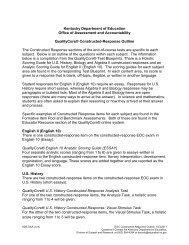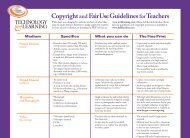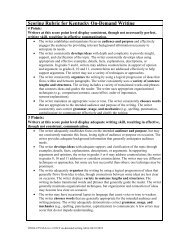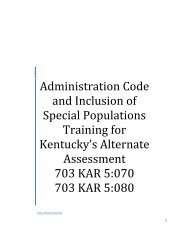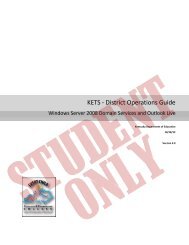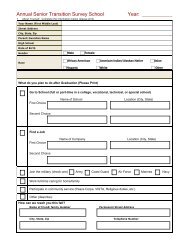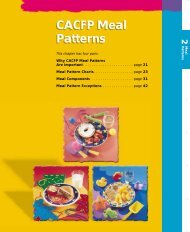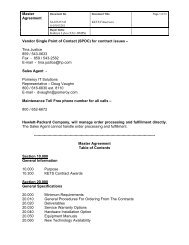Standards with Progressions grades K-HS v. 1.3 - Kentucky ...
Standards with Progressions grades K-HS v. 1.3 - Kentucky ...
Standards with Progressions grades K-HS v. 1.3 - Kentucky ...
- No tags were found...
Create successful ePaper yourself
Turn your PDF publications into a flip-book with our unique Google optimized e-Paper software.
Interpreting Functions F-IF<br />
Understand the concept of a function and use function notation<br />
1. Understand that a function from one set (called the domain) to another set (called the range) assigns<br />
to each element of the domain exactly one element of the range. If f is a function and x is an element of<br />
its domain, then f(x) denotes the output of f corresponding to the input x. The graph of f is the graph of<br />
the equation y = f(x).<br />
2. Use function notation, evaluate functions for inputs in their domains, and interpret statements that use<br />
function notation in terms of a context.<br />
3. Recognize that sequences are functions, sometimes defined recursively, whose domain is a subset of<br />
the integers. For example, the Fibonacci sequence is defined recursively by f(0) = f(1) = 1, f(n+1) = f(n) +<br />
f(n-1) for n 1.<br />
Interpret functions that arise in applications in terms of the context<br />
4. For a function that models a relationship between two quantities, interpret key features of graphs and<br />
tables in terms of the quantities, and sketch graphs showing key features given a verbal description of<br />
the relationship. Key features include: intercepts; intervals where the function is increasing, decreasing,<br />
positive, or negative; relative maximums and minimums; symmetries; end behavior; and periodicity. ★<br />
5. Relate the domain of a function to its graph and, where applicable, to the quantitative relationship it<br />
describes. For example, if the function h(n) gives the number of person-hours it takes to assemble n<br />
engines in a factory, then the positive integers would be an appropriate domain for the function★<br />
6. Calculate and interpret the average rate of change of a function (presented symbolically or as a table)<br />
over a specified interval. Estimate the rate of change from a graph. ★<br />
Analyze functions using different representations<br />
7. Graph functions expressed symbolically and show key features of the graph, by hand in simple cases<br />
and using technology for more complicated cases.★<br />
a. Graph linear and quadratic functions and show intercepts, maxima, and minima.<br />
b. Graph square root, cube root, and piecewise-defined functions, including step functions and absolute<br />
value functions.<br />
c. Graph polynomial functions, identifying zeros when suitable factorizations are available, and showing<br />
end behavior.<br />
d. (+) Graph rational functions, identifying zeros and asymptotes when suitable factorizations are<br />
available, and showing end behavior.<br />
e. Graph exponential and logarithmic functions, showing intercepts and end behavior, and trigonometric<br />
functions, showing period, midline, and amplitude.<br />
8. Write a function defined by an expression in different but equivalent forms to reveal and explain<br />
different properties of the function.<br />
a. Use the process of factoring and completing the square in a quadratic function to show zeros, extreme<br />
values, and symmetry of the graph, and interpret these in terms of a context.<br />
b. Use the properties of exponents to interpret expressions for exponential functions. For example,<br />
identify percent rate of change in functions such as y = (1.02) t y = (0.97) t y = (1.01) 12t , y = (1.2) t/10 , and<br />
classify them as representing exponential growth or decay. 9. Compare properties of two functions each<br />
represented in a different way (algebraically, graphically, numerically in tables, or by verbal descriptions).<br />
For example, given a graph of one quadratic function and an algebraic expression for another, say which<br />
has the larger maximum.<br />
Building Functions F-BF<br />
Build a function that models a relationship between two quantities<br />
1. Write a function that describes a relationship between two quantities. ★<br />
a. Determine an explicit expression, a recursive process, or steps for calculation from a context.<br />
b. Combine standard function types using arithmetic operations. For example, build a function that<br />
models the temperature of a cooling body by adding a constant function to a decaying exponential, and<br />
relate these functions to the model.<br />
<strong>Kentucky</strong> Department of Education<br />
c. (+) Compose functions. For example, if T(y) is the temperature in the atmosphere as a function of<br />
height, and h(t) is the height of a weather balloon as a function of time, then T(h(t)) is the temperature at<br />
the location of the weather balloon as a function of time.<br />
2. Write arithmetic and geometric sequences both recursively and <strong>with</strong> an explicit formula, use them to<br />
model situations, and translate between the two forms. ★<br />
Build new functions from existing functions<br />
3. Identify the effect on the graph of replacing f(x) by f(x) + k, k f(x), f(kx), and f(x + k) for specific values<br />
of k (both positive and negative); find the value of k given the graphs. Experiment <strong>with</strong> cases and<br />
illustrate an explanation of the effects on the graph using technology. Include recognizing even and odd<br />
functions from their graphs and algebraic expressions for them.<br />
4. Find inverse functions.<br />
a. Solve an equation of the form f(x) = c for a simple function f that has an inverse and write an<br />
expression for the inverse. For example, f(x) =2 x 3 or f(x) = (x+1)/(x–1) for x≠1.<br />
b. (+) Verify by composition that one function is the inverse of another.<br />
c. (+) Read values of an inverse function from a graph or a table, given that the function has an inverse.<br />
d. (+) Produce an invertible function from a non-invertible function by restricting the domain.<br />
5. (+) Understand the inverse relationship between exponents and logarithms and use this relationship to<br />
solve problems involving logarithms and exponents.<br />
Linear, Quadratic, and Exponential Models ★F -LE<br />
Construct and compare linear, quadratic, and exponential models and solve problems<br />
1. Distinguish between situations that can be modeled <strong>with</strong> linear functions and <strong>with</strong> exponential<br />
functions.<br />
a. Prove that linear functions grow by equal differences over equal intervals, and that exponential<br />
functions grow by equal factors over equal intervals.<br />
b. Recognize situations in which one quantity changes at a constant rate per unit interval relative to<br />
another.<br />
c. Recognize situations in which a quantity grows or decays by a constant percent rate per unit interval<br />
relative to another.<br />
2. Construct linear and exponential functions, including arithmetic and geometric sequences, given a<br />
graph, a description of a relationship, or two input-output pairs (include reading these from a table).<br />
3. Observe using graphs and tables that a quantity increasing exponentially eventually exceeds a<br />
quantity increasing linearly, quadratically, or (more generally) as a polynomial function.<br />
4. For exponential models, express as a logarithm the solution to abct = d where a, c, and d are numbers<br />
and the base b is 2, 10, or e; evaluate the logarithm using technology.<br />
Interpret expressions for functions in terms of the situation they model<br />
5. Interpret the parameters in a linear or exponential function in terms of a context.<br />
Trigonometric Functions F-TF<br />
Extend the domain of trigonometric functions using the unit circle<br />
1. Understand radian measure of an angle as the length of the arc on the unit circle subtended by the<br />
angle.<br />
2. Explain how the unit circle in the coordinate plane enables the extension of trigonometric functions to<br />
all real numbers, interpreted as radian measures of angles traversed counterclockwise around the unit<br />
circle.<br />
3. (+) Use special triangles to determine geometrically the values of sine, cosine, tangent for ∏/3, ∏/4<br />
and ∏/6, and use the unit circle to express the values of sine, cosine, and tangent for ∏–x, ∏+x, and<br />
2∏–x in terms of their values for x, where x is any real number.<br />
4. (+) Use the unit circle to explain symmetry (odd and even) and periodicity of trigonometric functions.<br />
Model periodic phenomena <strong>with</strong> trigonometric functions<br />
5. Choose trigonometric functions to model periodic phenomena <strong>with</strong> specified amplitude, frequency, and<br />
midline. ★<br />
6. (+) Understand that restricting a trigonometric function to a domain on which it is always increasing or<br />
always decreasing allows its inverse to be constructed. (continued)<br />
58 | P a g e




